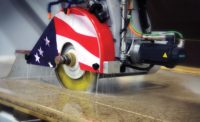There are several requirements for all surface types that apply across the board. These are generally related to the cleanliness of the substrate and its rigidity. All substrates must be structurally sound and should be free of any bond-breaking or bond-inhibiting materials. These bond-inhibiting materials can include sealers, waxes, curing compounds, form release agents, paint, dirt, grease, oils and similar potential contaminants.
There are several things we need to be aware of with concrete. One condition can be concrete laitance from overtroweling. This is the weak cement water slurry that is brought to the surface during the concrete finishing. This slurry is generally very weak in strength. Trying to adhere to this surface or any contaminated surface may result in partial if not complete loss of bond.
The other extreme is a very dense and shiny concrete finish. Some concrete floors are finished to the point where the surface is almost glass-like. The adhesive mortars for stone and tile can have a hard time adhering to this type of surface. In addition, some additives used in the concrete mixture can also present bonding issues. If any additives are used, it may be best to consult with the manufacturer of those additives to determine if there will be any potential bonding issues.
Any bond-breaking or bond-inhibiting materials must be completely removed prior to the commencement of the installation. One of the best ways to remove these contaminants is by mechanical abrasion. Usually, the contaminants have penetrated into the substrate's pores and have now blocked the adhesives' ability to create a mechanical bond or attachment to the surface. It is not a good idea to use chemicals or acid to strip and remove contaminants. These chemicals or acids can also get into the substrate and will be virtually impossible to thoroughly remove. Some other potential bond breakers can include ice on the surface or a frozen surface.
Residential renovation projects can present even greater substrate problems. You really never know exactly what you will find when you walk on a project. In addition to the potential bond breakers mentioned above, you may run into various old adhesives. One of the most common types is the yellowish, rubber-like adhesive used under carpeting or some resilient floors. This material needs to be removed prior to installing new stone and tile. This type of adhesive is weak and “rubbery.†It can break apart internally. When a failure occurs with these adhesives, the stone and tile mortar almost always shows traces of the existing adhesive adhered to it. The new stone and tile adhesive mortar is trying to do its job; it's trying to grab onto something; unfortunately it has grabbed onto the old existing adhesive that has broken apart internally or pulled away entirely from the substrate. So how do you remove substrate contaminants? Some of the common types of surface preparation equipment include shot blasting / bead blasting.
Some other items that need attention is the cure time for new concrete. It may be a good idea to determine the moisture vapor emission rate if the finish material and the installation system is sensitive to this condition.
At this point we have a clean surface. Are we ready for tile? Not yet. We now need to make sure that the surface is rigid enough to accept the stone or tile finish. The Ceramic Tile Handbook published by the Tile Council of America explains that it is the responsibility of the project architect or engineer to determine if the substrate meets the proper deflection criteria. The substrate needs to meet the maximum allowable surface deflection for the finish and the installation system that will be installed. Keep in mind that deflection is the potential movement that the installation can experience when subjected to use.
Stone and tile is very rigid and does not accommodate excessive movement, so all substrates must meet the maximum allowable ratings of: L/720 deflection rating for stone and L/360 deflection rating for ceramic tile.
An interesting fact is that 78% of all stone installations and 70% of all ceramic tile installations do not meet appropriate deflection ratings. How can we figure the amount of movement my tile floor will experience? Usually, this should already have been done by the time you begin a project by the architects or engineers. However, renovation projects may again present the biggest challenge in this area. The following are a few formulas that you can use as a rule of thumb.
If installing a stone floor, then we need to meet the L/720 requirement. This can be explained as L/720 or 1 inch (2.5 cm) of deflection over a 60-foot (18 m) span
• L = Length of span
• 720 = Number of inches in 60 feet (18 m)
• Example - if floor joist length is 288 inches (24 feet or 7.32 m) then
the substrate can only experience 288 inches / 720 inches = .4 inch (1 cm)
of movement.
It is important to note that these deflection standards are the minimum requirements for the surfaces. The potential added weight of any appliances, stone countertops or even the intended use of the area needs to be taken into consideration. For example, a room that will be used to entertain guests will require a more stringent deflection rating than an area subjected to less stress.
Another area of confusion exists in the L/360 designation. It is important to note that the L/720 deflection required by the stone industry and the L/360 deflection criteria required by the ceramic tile industry are subjected to a 300-pound concentrated load. This is much different than the L/360 building code requirement deflection rating which is usually distributed uniformly over the entire area. The concentrated load will require a much stiffer surface.
The surface to be tiled should also be within the manufacturers required temperature range. The surface to be tiled needs to be smooth enough to receive the stone or tile. Industry standards require the surface to be true and level with a maximum variation in the substrate not to exceed 1â„4 inch in 10 feet. Some installations may even require a more stringent tolerance for surface plane irregularity. How about when a pitch is required towards drains or scuppers? As a rule of thumb, the industry requires 1â„4 inch per foot slope for maximum water evacuation.
In order to adjust irregularities in the substrates, high-strength patching, leveling or screeding mortars can be used to bring the substrate into compliance.
Non-structural shrinkage or spider-web-type cracks can be treated with a crack isolation or anti-fracture membrane to help reduce the potential for the transmission of those cracks through the finish surface.
It is a good idea to follow the substrate requirements listed in the unique application that will be used. The Tile Council of America Handbook for Ceramic Tile Installation provides direction for the requirements on tiling over acceptable substrates.
Some examples are as follows:
Requirements for Mortar Bed
• Well compacted
• Appropriately sloped
• Unbonded mortar bed; minimum thickness and wire-reinforced (1 to 1â„4-inch min. - 31 mm)
• Bonded beds; no minimum thickness required. Slurry bond coat is required.
• Waterproofing membrane - if necessary
Requirements for Exterior Glue
Plywood (EGP)
• Interior only
• No chemical treatments (e.g. marine grade or pressure treated plywood)
• Refer to industry standards for design criteria
• Waterproof - if necessary
• Expansion joints
• Deflection guidelines
There are also a whole host of uncommon substrates that can be tiled over if the correct installation system and technique is utilized. Some of these surfaces include, but are not limited to: existing stone or ceramic tile, vinyl composition tile, resilient floors, epoxy terrazzo, seamless epoxy floors, gypsum concrete underlayments and steel. Consult with the installation materials manufacturer for detailed instructions for these surfaces. In contrast, there are many unsuitable substrates. Do not install stone or tile directly to:
• Luan
• OSB (Oriented Strand Board)
• Particle Board (any variety)
• Marine Grade or Fire Retardant Plywood
• Hardwood Flooring
• Foam Board
• Masonite®
As far as the costs that may be associated with bringing a substrate into compliance with the industry requirements, this can become a hotly contested issue. It is always a good practice to detail what surface preparation materials and techniques are being carried in your quote. Most general contractors and even homeowners assume that the tile installer owns the floor preparation. Obviously, a tile installer rightly believes that it is part of someone else's work. This type of dispute is very common. This is probably one of the reasons why not enough attention is given to this issue. Each party believes it is the responsibility of the other party and usually shortcuts are taken. The matter of compensation can come into play to. It is better not to start the work unless you have a signed change order from the party responsible for your payments in hand.
We all have a vested interest in installing permanent trouble free tile and stone installations. This helps to promote greater consumption of ceramic tile and stone. As this consumption grows, all of us in the industry benefit. Therefore, let's make sure that to finish off a successful tile installation, start with good surface preparation.

